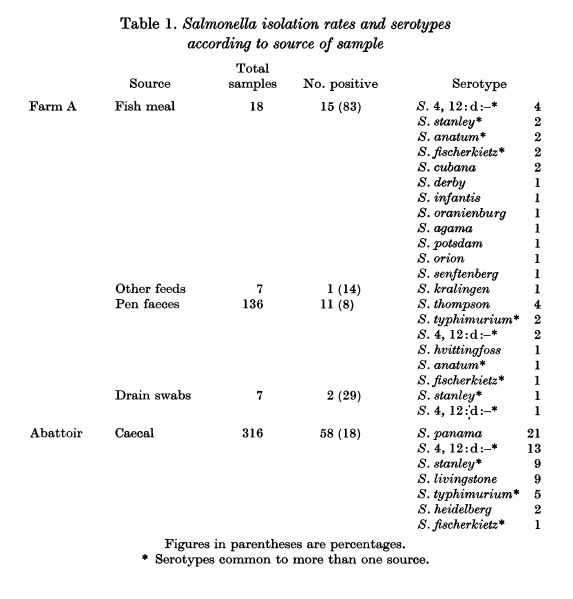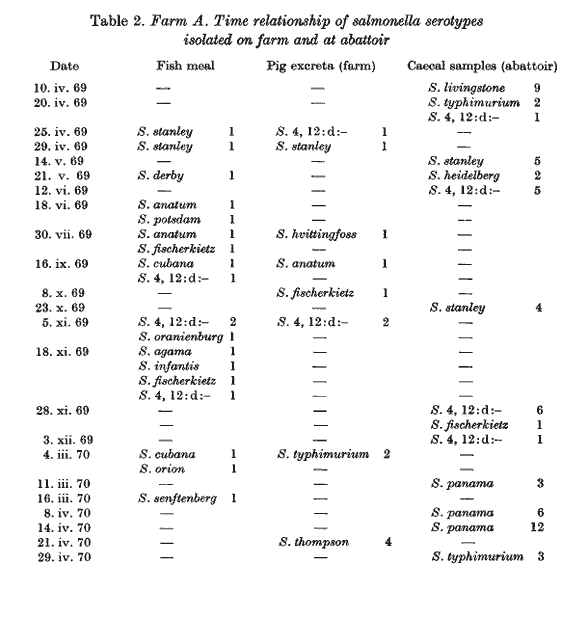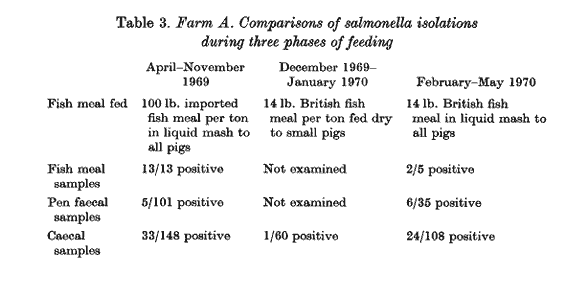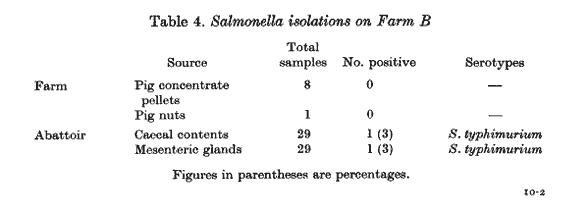Swine Articles on Food Safety
Since the passage of the Food and Drugs Act in 1906, the public has agreed that the consumption of healthy food animals is in the best interest of public health.1 Today, public health risks not detected by traditional visual inspection procedures in the packing plant include chemical or antibiotic residues and foodborne pathogens. The "one medicine" concept, or the close association of the medical and veterinary professions for the health of all species, is often discussed; however, it is unclear how veterinary care specifically impacts public health risks. Accurate quantification of this risk-risk relationship between animal health and public health is essential for effective policy-making.
The use of drugs in animals is fundamental to animal health and well-being. Antimicrobials are needed for the relief of pain and suffering in animals. For food animals, the gains that have been made in food production capacity would not have been possible without the ability for reliable drugs to contain the threat of disease to animals. The increased capacity of the United States livestock and poultry producer has kept high quality protein available and affordable for the majority of the U.S. consumers and consumers in many other countries. The World Health Organization stated, "Antimicrobials are vital medicines for the treatment of bacterial infections in both humans and animals. Antimicrobials have also proved to be important for sustainable livestock production and for the control of animal infections that could be passed on to humans." And the report by the National Research Council and Institute of Medicine states, "The benefit to human health in the proper use of antibiotics in food animals is related to the ability for these drugs to combat infectious bacteria that can be transferred to humans by either direct contact with the sick animal, consumption of food contaminated with pathogens from animals, or proliferation into the environment." However, the use of antimicrobials in food animals is not without risks.
After years of detailed study and analysis, the Food and Drug Administration has concluded that meat and milk from clones of cattle, swine (pigs), and goats, and the offspring of clones from any species traditionally consumed as food, are as safe to eat as food from conventionally bred animals. This conclusion stems from an extensive study of animal cloning and related food safety, culminating in the release of three FDA documents in January 2008: a risk assessment, a risk management plan, and guidance for industry.
Researchers have been cloning livestock species since 1996, starting with the famous sheep named Dolly. When it became apparent in 2001 that cloning could become a commercial venture to help improve the quality of herds, FDA's Center for Veterinary Medicine (CVM) asked livestock producers to voluntarily keep food from clones and their offspring out of the food chain until CVM could further evaluate the issue.
Salmonellas on pig farms and in abattoirs
Salmonella infection on two pig farms and its relation to infection in pigs at slaughter was studied. On the first farm feed ingredients were mixed on the farm, and these included fish meal which was found to be contaminated with salmonellas. The feed was pumped to pigs in liquid form. There was a high salmonella isolation rate at slaughter when the contaminated fish meal was fed in liquid feed, but it was significantly lower when no fish meal was fed to the pigs examined at slaughter. In some instances the same serotypes were found in fish meal and pig excreta on the farm and in caecal contents of the pigs at slaughter. No serotype was repeatedly isolated from any source and it appeared that the serotypes were not able to establish themselves in the pigs. It is concluded that infection found at slaughter originated on the farm where fish meal introduced and maintained infection. There was an opportunity for salmonellas to have multiplied in the liquid feed for several hours each day.
On a second farm environmental conditions were similar, but feed was given in the form of ready-made pellets and nuts. Salmonellas were not isolated from the feed. At slaughter there was a significantly lower isolation rate than on the first farm.
The investigation of salmonellas in pigs and feeding stuffs in the West Country of England established that pigs at abattoirs commonly harboured salmonella serotypes pathogenic to man. Many of these serotypes were also present in feed ingredients before compounding. This suggested that contaminated feeding stuffs could be a source of infection in pigs. It was realized that the compounded feeding stuffs actually consumed by pigs might not be so heavily contaminated, as the compounding in factories would dilute the contamination. In addition, certain farmers obtained their own ingredients and mixed them on the farm. We decided to examine, where possible, feeding stuffs consumed by pigs on farms and to investigate pig faeces on the farms and at slaughter. It was hoped that this study would yield information on the role of feed in introducing salmonellas into pigs, and clarify problems of cross-infection and environmental contamination. We also wished to obtain information on changes of serotypes in the pigs corresponding to changes in the salmonellas found in the feeds.
FARM STUDIES
Farm A
During the course of an abattoir study, Bath Public Health Laboratory identified a farm on which pigs were infected with salmonellas. A detailed investigation of this farm was made over a period of one year; feed and pig faeces were sampled on the farm and caecal samples of animals from this farm were taken at the abattoir. The farm was a semi-intensive fattening unit. It contained about 2000 pigs, up to 30 being housed in each pen.
Pigs were taken from a number of breeding farms at 10 weeks and 60 lb. weight and fattened for 16 weeks to 200 lb. weight. There was no history of any clinical illness in the pigs. The feed was mixed from purchased ingredients in a tank of approximately 6000 gallons capacity. Liquid feed was pumped through pipes to troughs in the pens which were above ground level. Drinking water from the mains was added to the troughs. Pipes were flushed with cold mains water once daily.
The standard of hygiene was good; floors of pens were concrete and were hosed down daily. Ingredients mixed by the farmer for the feed were millers' offal (flour), barley, a cereal mix, a vitamin supplement, fish meal and skimmed milk. The majority of feed samples examined were fish meal as it was the ingredient most probably contaminated, but all other ingredients were also examined. Regular samples of pen faeces were obtained and some farm drain swabs were examined. Caecal samples of pigs from the farm were taken concurrently at the abattoir, but it was not always possible to examine the same pigs from which pen samples had been collected on the farm.
Transport from the farm to the abattoir took three hours and pigs were slaughtered the following day.
Farm B
Farm B was investigated by the Dorchester Public Health Laboratory because of its different feeding practice to that of Farm A.
This farm was also a semi-intensive fattening farm obtaining pigs as 10-week weaners from several different sources. They were fattened for 12-14 weeks to a weight of 140-160 lb. There were just over 400 pigs which were housed under cover in pens each containing about 25 pigs. Pens had concrete floors and galvanized dividing walls and were cleaned out each day. The animals fed themselves ad lib. from dome-shaped hoppers up to a weight of 100 lb. Above 100 lb. each pig was fed half a pound per day and the feed was placed on wooden sleeping boards in the pens. The feed was in the form of pellets and nuts and supplied ready-made by the manufacturers.
During the period of study droppings indicated that rats were present on the farm. There were 50 ewes on the farm which were kept separate from the pigs. There was no clinical illness in the animals or the farm workers.
Farm samples of feed were taken and caecal faeces and mesenteric glands from pigs at the abattoir. The abattoir was approximately an hour's journey away and the pigs were killed almost immediately after arrival. Sampling was carried out for a period of 3 months.
MATERIALS
Farm
Feed samples were collected into plastic bags, and pen faecal samples were taken with wooden spatulas from the floors and placed into waxed cartons (Mono), which were packed in large plastic bags. Sewer swabs were placed in the main pig drain and removed the same day or left for a few days before removal. They were sent to the laboratory in sterile glass jars.
Abattoir
Caecal samples were removed from the pig at the abattoir by excising the caecum between two ligatures, placing it in a suitable container and sending it to the laboratory for examination. Mesenteric glands were removed by dissecting out the gland and enucleating it from surrounding fat.
Methods
Selenite F broth, or tetrathionate broth, was used as enrichment medium. Incubation was carried out at 37 or 430 C. (Harvey & Thomson, 1953) and subcultures were made at 24 hr. to deoxycholate citrate sucrose agar, brilliant green MacConkey agar (Oxoid) and Wilson and Blair's bismuth sulphite agar (Oxoid). Plates were incubated at 370 C. for 24-48 hr. and suspicious colonies picked for further examination. Quarter strength Ringer's solution and nutrient broth were used for preenrichment for feed samples and incubated at 37° C. Double strength selenite broth was then added to the enrichment cultures.
RESULTS
Farm A
Table 1 shows results of all sampling on Farm A and the abattoir over the 1-year period. During this time, abattoir caecal samples were collected on 24 occasions and feed and pen faecal samples from the farm on 14 occasions. Fifteen of 18 fish meal samples contained salmonellas. Thirteen of these 18 samples were imported meal and all were positive. One of three British fish meals was positive and one out of two meals of unknown origin. Seven samples of feed ingredients other than fish meal were examined and only one (a sample of millers' offal) contained salmonellas. Eleven of 136 pen faecal samples and two of seven drain swabs taken on the farm were positive. At slaughter 58 (18 %) of 316 caecal samples contained salmonellas. Twelve serotypes were found in fish meal and thirteen in all feed samples. Seven were found in pig exereta (faeces and drain swabs) and seven in caecal samples at slaughter.

Table 2 shows the timing of isolation of serotypes from different sources. Dates on which positive samples were obtained are shown and number of isolations of each serotype. One or two fish meal samples were taken on each occasion, about a dozen pen faecal samples, one farm drain swab and 6 to 12 caecal samples. In general, no serotype was isolated consistently or consecutively from a source for any length of time, although for 1 month Salmonella panama was found on three sampling occasions from caecal contents at slaughter. The monophasic serotype S. 4, 12: d:- was most frequently isolated from all sources. S. stanley, S. 4, 12: d:- and S. fischerkietz were found in fish meal, pig exereta on the farm and also in faeces at slaughter, and S. anatum in fish meal and in pigs on the farm. Sometimes the same serotype was present in more than one source within a short time. S. stanley was found in two samples of fish meal, taken within 4 days (April 1969) and in pig sewage on the farm on the same day as the second sample; 2 weeks later S. stanley was isolated from caecal contents of five pigs at slaughter (May 1969). S. anatum was found in two samples of fish meal in a period of 6 weeks (June and July). Six weeks later (September) it was present in a pen faecal sample. S. 4, 12: d:- was found in two samples of fish meal and in two samples of farm faeces on the same day (November); 2 weeks afterwards it occurred again in fish meal and 10 days later in pig caecal samples. S. fischerkietz was found in a sample of fish meal (November) and 10 days subsequently in caecal faeces at the abattoir.

Change of feed
Sampling was carried out for just over 1 year, from April 1969 to May 1970. As a result of changes in feeding practice, this period could be divided into three separate phases (Table 3). The changes involved the animal protein constituent, the other feed ingredients remained constant.

The first period ran from early April 1969 to the end of November 1969, during which time pigs were fed on imported fish meal. This was added to the feed mixture in the proportion of approximately 100 lb. per ton. At the end of November supplies of imported fish meal were stopped and it was replaced by skimmed milk as the main animal protein ingredient.
This second phase stretched from the end of November 1969 to the end of January 1970 during which time no foreign fish meal was added to the feed mixture, although a reduced ration of British white fish meal (14 lb. per ton of total feed) was fed in a dry form by hand only to small pigs (10-14 weeks old).
The third period stretched from the end of January 1970 to the end of May 1970, when a similarly reduced ration of fish meal was added to the liquid feed mixture and fed to all pigs. During February, the source of the fish meal was unknown, but from February onwards only British white fish meal was fed. Table 3 compares the salmonella isolations from all sources during these three periods. During the first period (April to November 1969) all 13 samples of fish meal were positive and 5 of 101 pen faecal samples grew salmonellas. At the abattoir 148 caecal samples were taken, of which 33 (22 %) were positive. In the second period (December 1969 to January 1970) no pen faecal samples or feed samples were taken and only one of 60 caecal samples at slaughter was positive. In the third period (February to May 1970), two of five fish-meal samples and six of 35 pen faecal samples were positive.
Twenty-four (22 %) of 108 caecal samples were positive. It was only in the second period (December and January) that contaminated fish meal was not fed in liquid form to any pigs and not fed at all to older pigs (14-26 weeks old) awaiting slaughter. In the first and third periods contaminated fish meal was fed through the liquid feed system to all pigs. The caecal isolation rate (1/60) for the second period was highly significantly lower than that of the first (33/148) and the third (24/108) period (X2 = 14-2, significant at the 01 % level).
Farm B
Table 4 shows results of sampling on Farm B. Samples of feed on the farm were taken on five occasions between January and March 1970. Eight samples of pig concentrate pellets and one sample of pig nuts were all negative for salmonellas. Among other ingredients the pig pellets contained meat and bone meal, meat meal and dried milk. At the abattoir caecal contents and mesenteric glands were examined from 29 pigs on four sampling occasions during February and March 1970. There was one positive caecal sample (3 %) and one positive mesenteric gland (3 %). Positive samples came from different pigs in a batch of eight. S. typhimurium was cultured from both.

DISCUSSION
nfection to abattoir infection and the relative importance offeed and farm environment in the ultimate infection of pigs at slaughter. Environmental factors on the two farms were similar, but feeding practice different. On Farm A, replacement of one feed by another assisted in evaluating the part played by feed. The findings on Farm A suggest that contamination of pigs at slaughter originated on the farm and not at the abattoir.
The high isolation rate and the serotypes isolated at the abattoir from pigs from this farm did not occur in pigs from other sources passing through this abattoir which was one of six investigated in the West Country pig and feeding-stuff study (PHLS Working Group, Skovgaard & Nielsen, 1972).
If abattoirs had been the main source of infection, similar isolation rates and the same serotypes would have been obtained from all pigs passing through the premises. Bevan Jones, Farkas, Ghosh & Hobbs (1964) showed that there was abattoir contamination of two serotypes (S. brandenburg and S. typhimurium) in lairages in which pigs were kept for periods of over a month and this led to a high isolation rate of these two serotypes of up to 90 % from mesenteric glands of these pigs at slaughter. Slaughterhouse regulations of 1966 have forbidden the keeping of animals for longer than 72 hr. Pigs from Farm A were slaughtered within 12-18 hr.
Serotypes were not consistently isolated from fish meal, pen or caecal samples. The longest period that a serotype was isolated was just over a month in the case of S. panama from caecal samples. This is interesting as S. panama, a serotype of increasing human importance, has been most commonly isolated from pigs and pork products. It may be considered to have a relative host adaptation to pigs. It was preceded by and replaced by different serotypes.
It thus appeared that no serotype was able to become established in the pigs. There was no opportunity for long-term excretors to give rise to persistent infection as there was a continuous throughput of pigs and young pigs did not mix with older pigs. Serotypes could only have become established by a lasting contamination of the environment which did not occur. Occasionally certain serotypes were found in the feed, the pig excreta on the farm and the intestinal contents at slaughter. In some instances there was a close time relationship between these isolations. On four of the eight occasions on which salmonellas were found in pen faeces there was a preceding or concurrent isolation of the same serotype in the fish meal. Some of the serotypes were found in pig excreta on the farm and not in the feed.
Smith (1960) also isolated some serotypes in the faeces of pigs fed contaminated feed from which the serotypes had not been isolated. He considered that these types had been present in the feed, but stated that there were technical difficulties in isolating individual serotypes from a number of other serotypes in materials such as fish and bone meal. Other serotypes were found in the fish meal, but not in the pig excreta or in the caecal contents. This confirms observations by Smith (1960). There is evidence that the pig acts as a biological filter and that different serotypes have different infective properties for the pig. Newell et al. (1959) reported that, from the same contaminated food, pigs became infected with S. orion whilst poultry became infected with S. infantis.
Salmonellas virtually ceased to be isolated from intestinal contents when no fish meal was fed to adult pigs and that being fed to smaller pigs was in dry as opposed to liquid form. Results on Farm A suggest that fish meal in the feed constantly introduced salmonella infection and that environmental contamination alone did not maintain this infection indefinitely. This confirms work done by Smith (1960) who showed experimentally that once feeding of salmonella-contaminated food to pigs stopped, excretion of salmonellas by the pigs could no longer be detected. His examinations were made from 6 to 20 days after ceasing to feed contaminated materials.
In a study carried out in an intensive pig-breeding farm (Ghosh, 1972), four serotypes persisted over a 2-year period. Boars and sows were retained for long periods of over 1 year and they were moved around to different houses, thus permitting dissemination and perpetuation of infection. There were opportunities for persistent cross-infection which did not exist on the fattening farm. It was reasonable to compare the results on Farm A with those on Farm B. Although Farm A had five times as many pigs as Farm B, the number of pigs to each pen was the same and the pens and standards of hygiene were similar.
The essential difference was the type of feed and method of feeding. On Farm B the pigs were fed on ready-made processed pellets and nuts and of nine samples examined not one was positive for salmonellas. At slaughter, caecal and mesenteric gland samples were examined from the same pigs. One out of 29 caecal samples (3 %) was positive and this was significantly different from the 18 % incidence in caecal samples from Farm A (X2 = 4X2, significant at the 5 % level). The implication of the results on Farm A is important as over 50 % of pigfattening farms in the United Kingdom mix their own feed. Most farms are not in a position to test raw materials, as large manufacturers do, and contaminated materials rejected by the big compounders find their way to farms.
Few farmers have facilities for pelleting and the majority of mixed foods are in the form of meals. On the farm investigated, the mixed meal was fed in a liquid form. In a sample of 864 pig farms taken by the Meat and Livestock Commission, pipeline feeding with liquid feed was used in 10-6 % of farms (Meat and Livestock Commission, unpublished data). Linton, Jennett & Heard (1970) investigated the question of salmonella multiplication in liquid feed. They showed that whilst approximately one salmonella was originally present per 1 ml. of liquid feed, as many as 200 salmonellas per ml. could be demonstrated after holding the feed at 200 C. for 24 hr. and 200,000 per ml. after 48 hr. at 20 and 280 C. This emphasized the fact that liquid feed held for a single day or residual feed left in feeding troughs and pipe-lines between feeds, could act as media for salmonella multiplication.
They further showed that salmonella excretion was only transient following the feeding of freshly prepared mash; after feeding this mash on 2 consecutive days excretion lasted 24 hr. only. In contrast after a single feed of mash held for 24 hr. at 200 C. excretion of salmonellas could be demonstrated for at least 37 days. On Farm A the liquid feed was made up each day using mains water and pumped into the troughs twice a day where it was usually consumed in 1-1 hr. The tank, which was under cover, was emptied once a day so that feed remained in the tank between feeds for about 7 hr. each day.
The temperature of the feed would vary with the atmospheric temperature. It is known that salmonellas in foods can multiply at temperatures ranging from 7 to 450 C. (Angelotti, Foter & Lewis, 1961). There was thus the opportunity for salmonellas to multiply in the tank before the second feeding, and multiplication could also have taken place if there had been any residual feed in the troughs, pipe or tank. The highly contaminated fish meal was foreign. Subsequent chemical analysis of a sample of this material showed that there were other ingredients present, including feather meal. About 75 % of fish meal fed to livestock in the U.K. is imported and such material is a likely source of exotic serotypes introduced into Britain.
The statistical analysis of this report was carried out by Mrs H. E. Tillett of the Epidemiological Research Laboratory, Central Public Health Laboratory, Colindale. We thank the Public Health Departments of Highworth Rural District and Dorchester Rural District for patiently collecting the farm and abattoir samples, also Dr Betty Hobbs of the Food Hygiene Laboratory, Central Public Health Laboratory, Colindale and Dr R. W. S. Harvey of the Cardiff Public Health Laboratory for their valuable help with the report.
By J.A.Lee, A.C.Ghosh, P.G.Mann, and G.H.Tee

